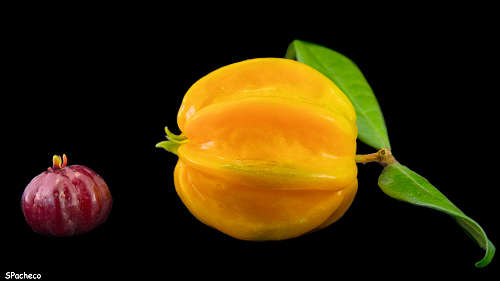Growing Star Cherry / Pitanga-tuba:
Eugenia selloi
Back to Fruit, Berries and Nuts
Botanical Overview
A member of the Myrtle family (Myrtaceae), the Eugenia genus contains over 1000 species worldwide, including several with edible fruit.
Description
Form:
Shrub.
Lifespan:
Perennial.
Leaf retention:
Evergreen.
Growth rate:
Slow.
Mature Size:
Normally 4-6' (1.2-1.8m) high and wide, but can reach 9' (2.74m) high.
Flowers:
Four white petals, many long white stamens with yellow tips, fragrant. These flowers do not
produce nectar.
Bloom:
Spring and summer for six months or more.
Self-fruitful:
Sometimes. A second plant may be needed if fruit does not develop or yield is low.
Years before fruiting:
2-3 from seed. Flowers that appear the first year of flowering often do not set fruit.
Fruit:
Aromatic, yellow to yellow-orange when ripe, ribbed, oval to round, 2-3" (5-7.6cm) long,
with persistent small apical sepals.
The flesh is juicy and nutritious.
The flavor of the ripe fruit varies between plants.
One description of the flavor is sweet, apricot mixed with mango, and hints of sour or
bitter, possibly latex.
Another description is passion fruit and mango mix.
Each fruit contains one oval, light brown seed which separates easily.
Months for fruit to ripen:
3-4 weeks. The fruit may drop off the plant when fully ripe.
It can be harvested when partially yellow and will finish ripening indoors.
Storage after harvest:
The fruit perishes rapidly. When ripe, it must be eaten raw, frozen, or cooked immediately.
Leaves:
Older leaves are dark green on top, light green underneath, oval with a slight pointed tip,
and thick. New leaves are yellow-green.
Stems:
No thorns. The outer bark on the trunk is rough and comes off in plates.
Roots:
New seedlings develop a strong taproot.
Cultivars of Note:
Varieties growing elongated fruit are said to have less latex in the ripe fruit than those growing round fruit. There are no cultivar names yet.
Varieties growing elongated fruit are said to have less latex in the ripe fruit than those growing round fruit. There are no cultivar names yet.
Wildlife:
The flowers attract bees. The fruit attracts birds and mammals.
Toxic / Danger:
Unripe fruit is mildly poisonous.
Origin:
Forest regions of Brazil.
Cultivation and Uses
USDA hardiness zones:
10-11. The leaves turn purple near freezing.
The plant is frost-sensitive but hardy to 26°F (-3.3°C) when well mulched.
Cover with frost fabric when temperatures are close to freezing.
Chill hours:
None.
Heat tolerant:
Yes.
Drought tolerant:
No.
Sun:
Full all day sun to part afternoon shade in summer.
Planting:
Locate this plant where it will receive full sun to part afternoon summer shade.
Avoid low lying areas where cold air collects.
Neutral to slightly acidic soil is required.
In the ground, plants can be spaced 2-6' (0.6-1.8m) apart.
Star Cherry does well in a large container.
Soil:
Well draining, slightly moist, pH 6.1-7.5 (slightly acidic to neutral). This plant grows in
nutrient-poor soil but thrives in soils with high organic content. It is slightly salt
tolerant.
Fertilize:
Use an organic fertilizer three times a year: mid-winter, mid-spring, and late summer.
Apply plant micronutrients in irrigation water at the same time and monthly during the
growing season.
Water after becoming established:
Deep water once a week during the warm season,
then taper to once a month in winter.
Mulch:
Apply organic mulch such as straw 1' (30cm) deep to retain soil moisture and protect roots
from temperature extremes.
First Year Care:
Do not fertilize.
Prune:
In winter, trim lightly to shape.
Litter:
Flowers, fruit if not harvested.
Propagation:
Seed is very slow to germinate. Like other Eugenia species, the seeds may be more likely to
germinate when they are planted within 10 days of being removed from the fruit and are not
dried. Rooting a woody cutting from a desirable plant, or grafting one to seedling
rootstock should be considered.
Uses:
Edible fruit eaten raw, cooked for jams and jellies, used to flavor ice cream; ornamental.
Comments
The scientific synonym of Star Cherry is Eugenia neonitida.
It is related to
Cherry of the Rio Grande,
Grumichama, and
Surinam Cherry.
Do you have additional information or a different experience for these plants that you would like to share? Email info@GardenOracle.com. All contributions are welcome and appreciated.
Do you have additional information or a different experience for these plants that you would like to share? Email info@GardenOracle.com. All contributions are welcome and appreciated.

A comparison of Surinam Cherry at left and Star Cherry at right
![By Fredericoscb (Own work) [CC BY-SA 4.0 (https://creativecommons.org/licenses/by-sa/4.0)], via Wikimedia Commons Eugenia selloi leaves and fruit](assets-images/eugenia-selloi.jpg)
Latest update: March, 2025
© 2008-2025 by GardenOracle.com

